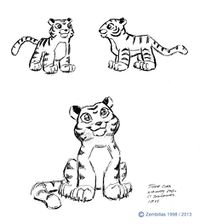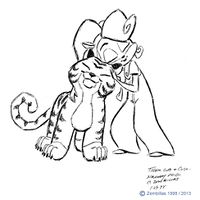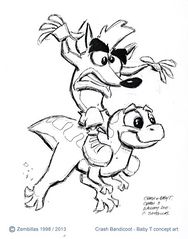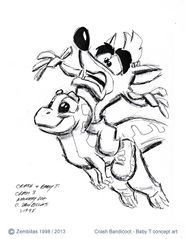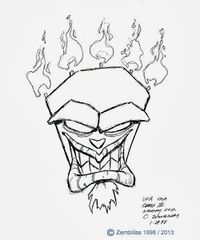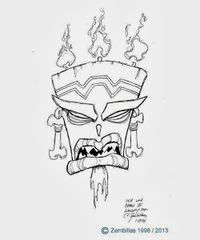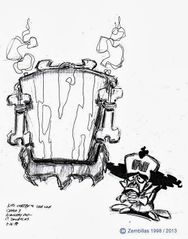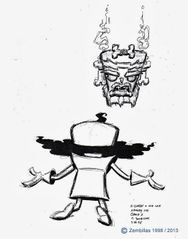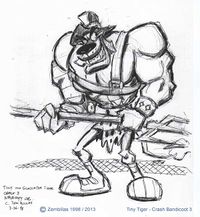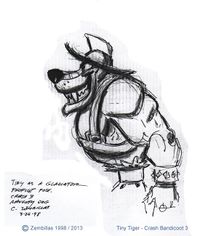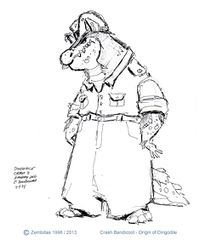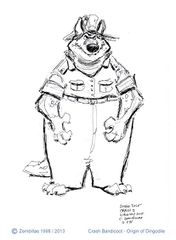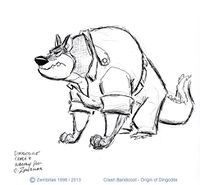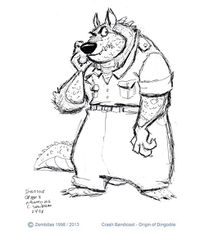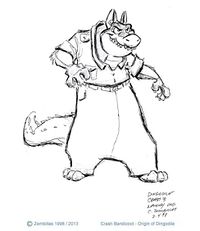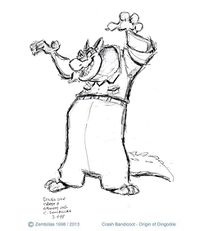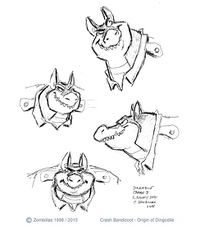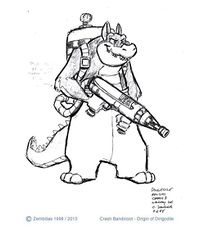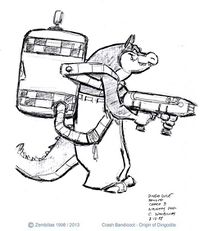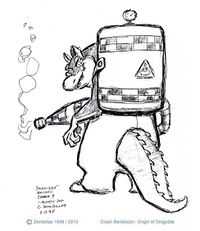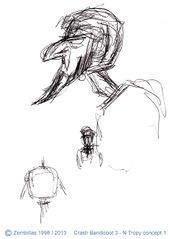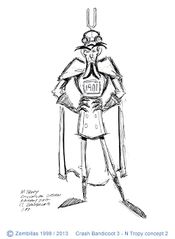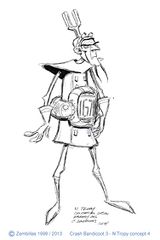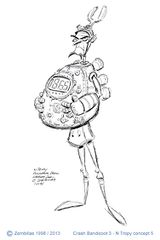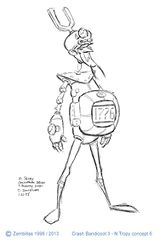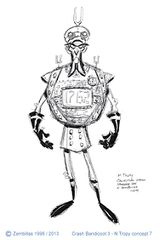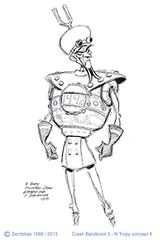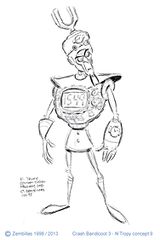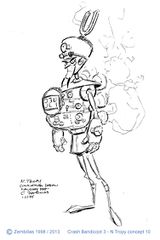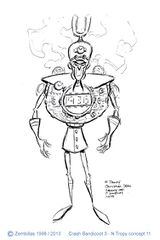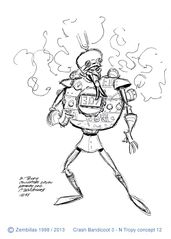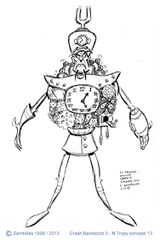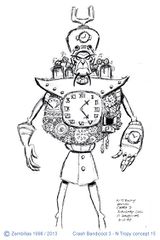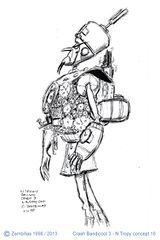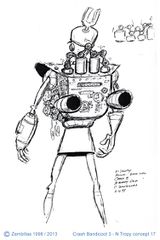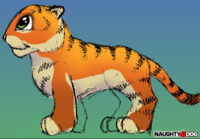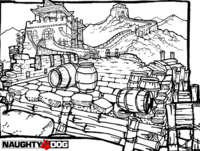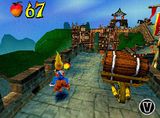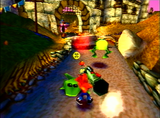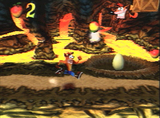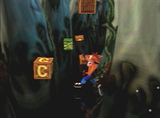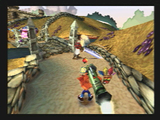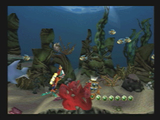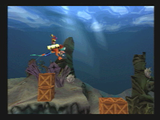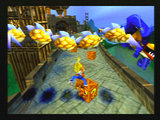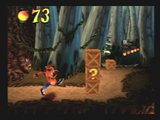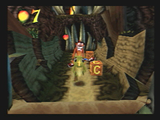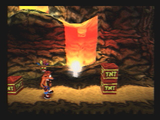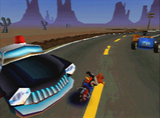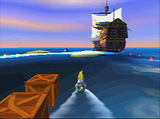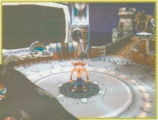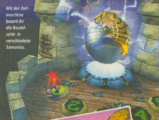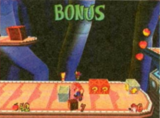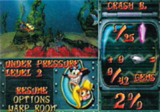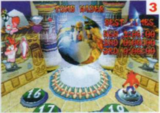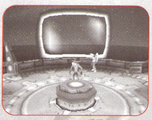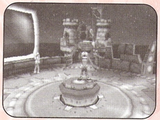Prerelease:Crash Bandicoot: Warped
This page details prerelease information and/or media for Crash Bandicoot: Warped.
To do:
|
Contents
Development Timeline
- January 1998
- The development of Crash Bandicoot: Warped begins.
- Pura's conceptual sketches are made.
- Uka Uka and N. Tropy's first conceptual sketches are made.
- February 1998
- Dingodile and Baby T's conceptual sketches are made.
- N. Tropy's reaches its final conceptual design.
- March 1998
- Uka Uka reaches its final conceptual design.
- Tiny Tiger's conceptual sketches are made.
- ~April 1998
- Press screenshots and a small handful of builds of some of the earliest publicly seen versions of the game are sent to previewers. The game would not be officially unveiled to the public until E3, at which point the game was more complete than these previews.
- May 28-30 1998
- The game is unveiled at E3 1998.
- A demo version with 5 levels was playable at the event. This demo was later sent out by SCEA and SCEE to a number of gaming publications across America and Europe for exclusive previews.
- July 17 1998
- The SCEE Preview Version 1 is built and sent out by SCEA and SCEE across multiple American and European publications.
- July 29 1998
- The standalone Toys "R" Us store demo is built.
- August 5 1998
- The hidden demo present in the NTSC-U region of Spyro the Dragon is built.
- August 14 1998
- A late "alpha version" is built and sent out by SCEA to be eventually previewed in some American magazines.
- August 16 1998
- A PAL region demo for PAL demo discs featuring Gee Wiz is built.
- August 24 1998
- Roughly the date of the other demo levels found on many NTSC-U demo discs featuring Under Pressure or Midnight Run, and the PAL region of the hidden demo in Spyro the Dragon.
- August 26 1998
- The SCEE Preview Version 2 is built and sent out by SCEE to multiple European publications. The game now enters the beta phase.
- September 26 1998
- The "reviewable version" is built and sent out by SCEA to multiple American publications.
- October 11 1998
- The SCEE Review Version is built. It is apparently dated the same day as the final build, which may have been intended as a release candidate.
- The initial NTSC-U build finished development in nine months and eight days after production started. [1]
- October 21 1998
- The standalone Japanese store demo is built.
- October 28 1998
- The PAL build finished development.
- November 4 1998
- The game is released in North America.
- November 19 1998
- The NTSC-J build finished development.
- December 5 1998
- The game is released in Europe.
- December 17 1998
- The game is released in Japan.
Concept Art
The following art was posted by Charles Zembillas, one of the main character designers for the game, on his blog in 2013. [2]
Characters
Pura
According to Naughty Dog, Pura was originally intended to be a panda bear but was later changed into a tiger cub so it wouldn't feel too similar to Polar from Crash 2 while also fitting in the theme of the China levels. Unlike his other creations, this time Charles was provided with a sketch from one of ND's artists and was directed to use it as a model for the design of the character.
The following sketches are dated January 29 1998.
Baby T
Early sketches of Baby T and Crash dated from February 12 to February 19 1998.
Uka Uka & Cortex
While Cortex's appearance remained unchanged, Uka Uka had a few minor differences to his design. Most notably his beard used to be much smaller, had different nose shapes and multiple flames above his head.
The following sketches are dated from January 29 to March 26 1998.
Tiny Tiger
Tiny's appearance didn't change other than he was now wearing a gladiator attire. One of the sketches depicts Tiny holding a net that he would throw at Crash to presumably capture him while Tiny would attack him during the fight. This got scrapped likely due to being too complex to program according to Charles.
The following sketches are dated March 26 1998.
Dingodile
Dingodile's design changed throughout the game's development varying from a more animalistic appearance to an Australian-looking one. Apparently, at some point he would walk on all fours. According to Charles, Naughty Dog originally wanted Dingodile to be a fire-breathing character similar to a dragon, but he suggested giving him a weapon (like a flamethrower) to make him "much more interesting".
The following sketches are dated from February 4 to February 12 1998.
N. Tropy
Early sketches depict Nefarious Tropy having two beards and wearing a cape. Originally, he had a belt-like time traveling device wraped around his waist with a digital display showing the year he intended to travel to but was later changed to look more industrialized. By February 12 1998, N. Tropy mostly resembled his appearance in the final game. However, his suit had now a complex array of pistons, gears and other clockwork, intended to add absurdity to his character. Charles hoped these would be implemented as drawn textures placed over his model in the game but this was deemed to be too complex, eventually simplifying the suit in his final design.
The following sketches are dated from January 22 to February 19 1998.
Other
Environments
Early Builds
The game as officially unveiled at E3 1998. Several press screenshots were included in a few press kits throughout the months depicting the earliest versions of the game.
There are at least two builds that predate the E3 demo - the one shown in the Total Play Magazine VHS, and a second one shown in the direct feed of the Electric Playground's E3 1998 coverage. Although both are largely similar, the one shown in the Electric Playground episode also includes a portion of Tomb Time, a level not present in the VHS footage.
The first video was released in September 1998 by French publication Total Play Magazine, which released a promotional video called Découvrez les futurs hits PlayStation 98 VHS containing gameplay previews of a lot of games, including Crash: Warped. In spite of the date, this might be the earliest Crash 3 footage to surface, and highlights lots of fascinating differences.
General Differences
- There is no title screen. Instead, a plainly-titled "Crash 3" is seen above a level select that lists seven available options (none of the levels have proper names at this point).
WARP ROOM
GREAT WALL1 (Orient Express)
GREAT WALL2 (Midnight Run)
MEDIEVAL1 (Toad Village)
MEDIEVAL2 (Gee Wiz)
ATLANTIS1 (Under Pressure)
PREHISTORIC1 (Bone Yard) - The warp room is in a very primitive state and with a very early design. The floor has Cortex's face on it, and only the first chamber is available. The load/save monitor has an extremely different design.
- The background is much plainer, appearing to be a solid gradient.
- The buttons have a completely different style, being pitch black and using a green 80's computer font, similar to the "Load/Save" text in later warp room iterations. The button frames are also tinted yellow.
- Instead of a boss button, there is a number 6 button due to the fact that only six levels were finished at the time and no boss levels were present.
- When Crash stands on a button it lights up from below, followed by the portal pad lighting up, instead of a warp sphere.
- The portal pad has a different design which was eventually re-used for the secret warp room.
- All of the UI is missing, including the level name and crystals and gems obtained.
- Crash is seen sighing while standing on a button, but he only ever plays his default animation (no sighing or any other idle animations) when he stands on a button in the final game.
- A lot of elements present in this build are incomplete and use placeholders lifted from Crash 2. Namely:
- Naughty Dog screen from Crash 2 seen at the start of the footage, except Crash itself is not present.
- The white screen used for loading transitions, rather than a distorting vortex effect.
- The Crash 2 game over screen, complete with Cortex.
- The warp animation, exit warp, and the corresponding warp sounds upon reaching the level's end. This coincides with the fact the warp chambers do not show warp spheres in this version.
- Checkpoint crates lacking the chime sound.
- The drop shadow is a dark circle instead of the more accurate shadow used in the final game.
- There's a lot going on in the audio department as well. As...
- There is no music at any point heard in the footage.
- A lot of sound effects to elements that would be heard in the final are missing. The SFX that are heard are either glitched, improperly assigned, or just obviously a placeholder. Noteworthy are:
- The normal spin sound effect is used underwater.
- The TNT beep sound effect plays twice at the end of the first section of the triceratops chase in Bone Yard, which seems to be used as a placeholder sound for an early iteration of the slot crate, which still featured the regular crate design.
- Aku Aku has a red nose.
- Bonus rounds appear to be missing from the levels.
- There are no box counters at the end of the levels.
Toad Village
- There are no swallows or butterflies at all.
- The chicken don't scream or drop feathers when shot by the Fruit Bazooka.
- After the second puddle of water, the ? crate is missing, and the second Aku Aku crate is merged into the pile of three crates - the pile is also placed further to the left.
Gee Wiz
- The sky background has a purple coloration.
- The prince lab assistant has a blonde hair.
- The wizards have an extra hit point. When you hit them for the first time, their robes and beard will disappear and they'll stay in their underpants, similar to when you shoot them with the bazooka in NTSC-U (this was re-added in the PAL version).
- They also have no shadow.
- The crate behind the first wizard lab assistant is a checkpoint one by default.
Under Pressure
- The background lacks the city details, and is more of a navy-blue color.
- The pufferfish are purple instead of red.
- Crash shouts "Whoa!" when inflated by a pufferfish.
- The underwater mine is completely different, both in color and design. It also appears to emit a small light beam from its top. The final mine is yellow and red, and has small bulbs.
- The mine's exploding animation in the final game actually still uses this model, but all of the textures that were used are long gone.
Orient Express
- Barrel wagons are smaller as the model is not stretched.
- There are two scaffoldings holding hanging baskets on the left side after the first barrel wagon that were removed in the final game. The background when passing through them also displays some flickering.
- Pura has a round shadow.
Bone Yard
- A lab assistant that didn't make it to the final game was supposed to be riding the triceratops that chases Crash.
- Crash uses the same animation for getting stomped on by a triceratops as he had for getting crushed by a boulder in Crash 2.
- The level has a nest with an egg in the side-scrolling area in front of a lava pit; the Baby T that comes out can be used for the final chase sequence that follows right after, though no triceratops will appear.
Tomb Time
- Before the first door switch, there is line of three crates on the left side of the scenery instead of one.
- The oil floor afterwards is missing, and instead the pit in front of the door is larger, which also contains a moving platform.
- The projectiles thrown by the jar monkeys are blue.
- You can spin the helpless monkeys away.
- The corridor with the first set of jar monkeys is narrower.
- The crate ahead is also a checkpoint one by default.
- The layout before the split-path is different - rather than a small pit between the two doors, there is one door and a large pit before it with two block platforms on either side that will activate in succession.
- A staggered spear trap is placed instead of a large gap at the beginning of the left path.
Hog Ride
- The race position is missing from the HUD.
Bye Bye Blimps
- Crash is a playable character instead of Coco.
- Instead of Crash's face, the health bar used to have an icon of his plane.
Tell No Tales
- The directional arrow is missing from the HUD.
E3 Demo
A demo was playable on the E3 1998 showfloor from May 28th to May 30th. This demo features the first chamber with five playable levels: Gee Wiz, Under Pressure, Bone Yard, Midnight Run and Tomb Time. It is particularly remarkable for an early version of the warp room featuring a rather unique Load/Save monitor design and the presence of a futuristic bonus round in Gee Wiz which has been completely scrapped in favor of a more robust one in keeping with the medieval theme of the level.
This version was later sent out to gaming publications for exclusive previews.
General Differences
- The demo starts with a warning screen labeling the demo a "E3 1998 DEMONSTRATION DISC".
- The startup screens are all slideshows of static images, including the title screen, which also uses a slightly different logo.
- A music track not used in the final version of the game plays here during the startup and as the main theme for the warp room.
- In the warp room, only the first chamber is available. The Time Twister in this version is explicitly located on top of the ruins of Cortex Castle, as the two other islands can be seen in the background - which are also based on the background of the secret warp room in Crash 2.
- Crash spawns in front of the third warp room entrance.
- The load/save monitor features a complete different design. The monitor has a more round design, and features three smaller screens on the top. Coco is also missing.
- This design could also be seen in the texture used for warp spheres leading to the warp room in many pre-release builds of the game, as well as in certain promotional materials such as the cover of the European version of the game.
- Crash doesn't get knocked back when touching the electric fence gates.
- There is no HUD showing the collectibles and level's name upon stepping on a button.
- The buttons are present even when far away, and have a completely different style.
- The portal pad has a different design which was eventually re-used for the secret warp room.
- Crash has a round shadow. All shadows in the final game are much more realistic.
- Super Powers are unlocked by default, presumably for showcasing purposes.
- Bone Yard uses a different portal graphic.
- A white screen is used for loading transitions, rather than a distorting vortex effect.
- Aku Aku floats on the right side of the character when they are facing away from the camera, rather than on the left.
- Slot crates drop their contents instead of being picked up automatically.
- Checkpoint crates make no sound when opened.
- The bonus levels didn't show a total box tally.
- The pause menu is based on Crash 2, having crystals and gems all in the same screen instead of separate tabs for each collectible.
- There are no box counters at the end of the levels.
- The Crash 2 game over screen is re-used as a placeholder.
Gee Wiz
- The sky background has a purple coloration.
- The level appears to have previously an unknown, unreleased music track that was never used in the final game.
- The wizards have an extra hit point. When you hit them for the first time, their robes and beard will disappear and they'll stay in their underpants, similar to when you shoot them with the bazooka in NTSC-U (this was re-added in the PAL version).
- Crash would tap his left foot after being sliced by a knight and before his legs walked away.
- The 2x2x2 locked crates at the start of the level are just a single one here.
- The puddle of water originally reached the wooden log just after it, where it stopped between the Aku Aku crate and locked crates in the final game.
- There is a pit before the two knight lab assistants next to the crystal.
Bonus Round
- Gee Wiz used to have an underground bonus theme filled with metallic structures and advanced machinery. This theme was likely taken off because it didn't make sense in the medieval era.
- The entrance to the bonus stage is a trapdoor that opens down, making Crash fall. These were commonly used in Crash 2 levels but were later entirely replaced with the hovering platforms.
- The texture of the entrance is also wooden and doesn't appear in the final game.
- The exit platform has a different style from the entrance, something that is never seen. The texture for this platform is a recolored variant of the platform used in Crash 2's Dynamo bonus rounds.
- There are 12 crates in total, bringing the total number of crates to 87 instead of 100.
- The entrance to the bonus stage is a trapdoor that opens down, making Crash fall. These were commonly used in Crash 2 levels but were later entirely replaced with the hovering platforms.
Under Pressure
- The background lacks the city details, and is more of a navy-blue color.
- The level uses the demo track originally composed by Josh Mancell for the underwater levels.
- The pufferfish are purple instead of red.
- The crystal is placed inside the tunnel leading to the exit portal, where the box counter would be located in the final game.
Bone Yard
- A lab assistant that didn't make it to the final game was supposed to be riding the triceratops that chases Crash.
- Crash uses the same animation for getting stomped on by a triceratops as he had for getting crushed by a boulder in Crash 2.
- The level has a nest with an egg in the side-scrolling area in front of a lava pit; the Baby T that comes out can be used for the final chase sequence that follows right after, though no triceratops will appear.
Midnight Run
- The level was originally called "Orient Express".
- Barrel wagons are smaller as the model is not stretched.
Tomb Time
- The fire from the flamethrower lab assistants has a shorter range.
- After the first wall trap section, a flamethrower lab assistant was replaced by a row of four Wumpa fruits, although this still remains the case in the PAL release.
- The door leading to the alternate path is a timed door instead of a purple gem door, which will lock out after about a minute inside the level.
- A staggered spear trap is placed instead of a large gap at the beginning of the left path.
- The second Aku Aku crate is also missing.
- There is a crocodile in the pit of the right path.
- The final checkpoint crate before the last oil floor section is placed after the oil floor, next to the lever pulling lab assistant.
- There are two pits on each side and a switch to open the final door ahead that were removed in the final game.
- The ! switch at the end of the level is placed on the right edge.
Miscellaneous
Additionally, three more levels are shown in the promotional trailer: Hog Ride, Bye Bye Blimps and Tell No Tales. It is not known if these levels were part of the E3 demo or from another build.
- Crash is a playable character in Bye Bye Blimps instead of Coco.
- Instead of Crash's face, the health bar used to have an icon of his plane.
- The race position is missing from the HUD in Hog Ride.
- It seems that Crash didn't need to go on boost pads to make wheelies.
Other Pre-Release Builds
July Prototype
The July 17th, 1998 prototype can be seen on some preview footage (including the website trailer) and many gaming magazines across US and Europe.
Japanese Prototype
An early Japanese prototype can be found on a trailer for MiruMiru PlayStation Vol 28. It appears to be very similar, if not identical, to the August 14th, 1998 prototype - it's possible that this was an NTSC-J variant of this preview build, so the major differences would be the early title screen and Japanese text, as well as potentially early localization work.
Late Prototype
A late pre-release build of the game seemingly dated a few days after the August 26th, 1998 prototype was shown in some American sources and in the Crash Bandicoot III: Warped - Totally Unauthorized Pocket Guide, an unofficial strategy guide released by Brady Games a few weeks before the game's initial release.
General Differences
- The lowest relic tier is now Sapphire.
- The stopwatch balloon in Baron levels is still yellow.
- The stopwatch still doesn't go away after shooting down airplanes in Mad Bombers.
- Aku Aku is kept between levels once again.
- The missile robot now has the final coloration.
- Bosses now appear in the portal graphics.
- All levels now have proper portal graphics.
- The game is now 100% completeable - the misassigned gem bug in Rings of Power has been fixed.
Fake Crash Origin
Fake Crash was initially created by Sony Japan marketing team for a Japanese commercial for Crash Bandicoot 2: Cortex Strikes Back. Naughty Dog thought it was so funny that they decided to put him in Warped as an easter egg.
“Fake Crash came from a Japanese commercial. They had this really funny commercial where some kids were chasing Crash and instead they caught "fake crash." We thought he was so funny, that put him in Crash 3 as a sort of easter egg. The Japanese loved it. Part of the joke too was that Universal had made a series of stuffed Crash toys which were SO UGLY, I mean SO UGLY, that they looked more like fake Crash than real Crash -- seeing them the first time in the marketing exec's office set me to literarily laughing for 30 minutes straight and rolling on the floor (Jason will verify). The marking peeps didn't think it was funny.”[3]
— Andy Gavin
Scrapped Vehicle
In an interview with the Naughty Dog's co-founder for the Next Generation magazine, Jason Rubin mentioned that despite the developers being able to include pretty much everything they wanted, some ideas were abandoned, such as another vehicle that would appear in the Future levels - some sort of floating device similar to a snowboard that Crash would hover in. The idea was scrapped because games with snowboards and other hovering things were very common at the time, and they didn't feel like copying that trend.
“With Crash Bandicoot: Warped, we knew what we wanted to do from the start. Almost nothing was cut. I guess that two previous titles had taught us what worked and what didn't. We had always wanted to do a free-roaming water level, as well as put Crash in planes and motorcycles. At one point we were thinking about a snowboard-like hover-thingy for Crash's use in the future levels, but everybody is doing snowboards and hover-thingies these days, so we never let that get very far.”[4]
— Jason Rubin
Music
Unused Hard Path Themes
Hard path themes were composed for nearly every level type, including those that never ended up with hard paths in the final game! Mancell's comments seem to indicate that the themes themselves were composed independently from the designing of the levels:
“I'm not sure if [these levels were] ever completed; that would be a Naughty Dog question. All I know is that I made "danger" variations of all the levels... including underwater, jet ski, etc.” [5]
— Josh Mancell
Throughout the years, Mancell has uploaded some of these themes to SoundCloud.
| Track | Description |
|---|---|
| A hard path variant for the Highway levels. | |
| A hard path variant for the Jet Ski levels. | |
| A hard path variant for the Baron levels. | |
| A hard path variant for the Atlantis levels. Interestingly, the level Deep Trouble did end up with a hard path in the final game. |
References
- ↑ Crash Bandicoot Time Line - Official Website
- ↑ Charles Zembillas Blogspot
- ↑ All Things Andy Gavin - Making Crash Bandicoot – part 3, page comments
- ↑ Next Generation Issue 48 (December 1998), page 145
- ↑ Josh Mancell's SoundCloud - "Crash Bandicoot: Warped - Moto Skull Route (outtake)", page comments
